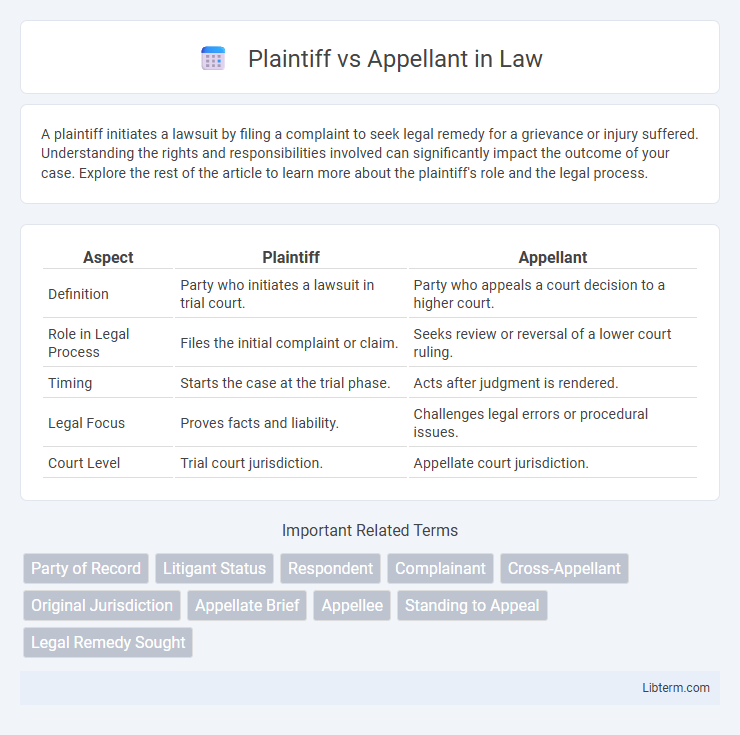A plaintiff initiates a lawsuit by filing a complaint to seek legal remedy for a grievance or injury suffered. Understanding the rights and responsibilities involved can significantly impact the outcome of your case. Explore the rest of the article to learn more about the plaintiff's role and the legal process.
Table of Comparison
| Aspect | Plaintiff | Appellant |
|---|---|---|
| Definition | Party who initiates a lawsuit in trial court. | Party who appeals a court decision to a higher court. |
| Role in Legal Process | Files the initial complaint or claim. | Seeks review or reversal of a lower court ruling. |
| Timing | Starts the case at the trial phase. | Acts after judgment is rendered. |
| Legal Focus | Proves facts and liability. | Challenges legal errors or procedural issues. |
| Court Level | Trial court jurisdiction. | Appellate court jurisdiction. |
Introduction to Plaintiff and Appellant
A plaintiff is the party who initiates a lawsuit by filing a complaint against another party, seeking legal remedy or compensation for an alleged wrong. An appellant is a party who appeals a court decision, requesting a higher court to review and change the lower court's judgment. Understanding the roles of plaintiff and appellant is essential in legal proceedings, as the plaintiff starts the case while the appellant challenges the outcome after judgment.
Key Definitions: Plaintiff vs Appellant
A Plaintiff is the party who initiates a lawsuit by filing a complaint in the trial court, alleging wrongdoing by another party and seeking legal remedy. An Appellant is the party who appeals a court decision, challenging the trial court's ruling and requesting a higher court to review and reverse or modify the judgment. Key distinctions include that the Plaintiff starts the original case, while the Appellant engages in the appellate process after a final judgment.
Roles in Legal Proceedings
The plaintiff initiates a lawsuit by filing a complaint, seeking legal remedy for a perceived wrong or injury. The appellant, on the other hand, is a party who appeals a court's decision, challenging the judgment after the trial court's ruling. Both play crucial roles in the legal proceedings, with the plaintiff primarily involved in the trial phase and the appellant active during the appellate review process.
Legal Rights and Responsibilities
A plaintiff initiates a lawsuit by filing a complaint seeking legal remedy for a grievance, bearing the responsibility to prove the case's merits. An appellant, usually a party dissatisfied with the trial court's decision, exercises the right to challenge that decision in a higher court based on alleged legal errors. Both roles carry specific legal responsibilities: the plaintiff must establish standing and evidence, while the appellant must demonstrate grounds for appeal within prescribed procedural rules.
Differences in Civil and Criminal Cases
In civil cases, the plaintiff is the party who initiates the lawsuit to seek damages or specific performance, whereas the appellant is the party appealing a court decision after the trial's conclusion. In criminal cases, the government or prosecution acts as the plaintiff, bringing charges against the defendant, while the appellant is usually the defendant challenging a conviction or sentence. The plaintiff's role centers on presenting the initial claim, while the appellant's role is limited to contesting legal or procedural errors in the original judgment.
How a Plaintiff Becomes an Appellant
A plaintiff becomes an appellant by appealing a court's decision after an unfavorable judgment in their initial case, seeking a review from a higher appellate court. This transition occurs when the plaintiff files a formal notice of appeal, challenging the trial court's ruling on legal grounds. The appellate court then reviews the record to determine whether errors in law affected the trial outcome, which distinguishes the appellant's role from that of the original plaintiff.
Legal Process Flow: From Plaintiff to Appellant
The legal process flow begins with the plaintiff initiating a lawsuit by filing a complaint in the appropriate court. After trial and judgment, if the plaintiff or defendant disagrees with the outcome, the dissatisfied party may become an appellant by filing a notice of appeal to a higher appellate court. The appellate court reviews the trial court's record for legal errors, focusing on whether the lower court correctly applied the law rather than reexamining factual evidence.
Common Misconceptions
A common misconception is that the terms "Plaintiff" and "Appellant" are interchangeable, but they refer to distinct legal roles; a Plaintiff initiates a lawsuit in trial court, while an Appellant challenges a court's decision on appeal. Many believe an Appellant must always be the Plaintiff, yet any party dissatisfied with a lower court ruling, including defendants, can be an Appellant. Understanding this distinction is crucial for accurately navigating litigation phases and legal procedures.
Importance in the Judicial System
The plaintiff initiates a lawsuit by filing a complaint, seeking judicial relief for alleged harm or rights infringement, playing a crucial role in enforcing legal protections. The appellant challenges a trial court's decision by appealing to a higher court, ensuring errors in the judicial process can be reviewed and corrected, which maintains the integrity of the legal system. Both roles are vital in promoting justice, accountability, and the consistent application of law across cases.
Conclusion and Key Takeaways
Plaintiff and appellant represent distinct roles in legal proceedings, with the plaintiff initiating the lawsuit and the appellant challenging a court decision on appeal. Understanding their differences is crucial for grasping case progression and litigation strategies. Key takeaways include that the plaintiff seeks remedy or damages, while the appellant aims to reverse or modify a lower court ruling.
Plaintiff Infographic

 libterm.com
libterm.com